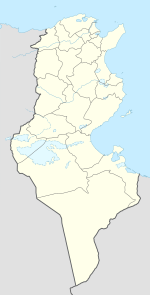Battle of Medenine
| Battle of Medenine | |||||||
|---|---|---|---|---|---|---|---|
| Part of the Tunisia Campaign of the Second World War | |||||||
 Battle of Medenine |
|||||||
|
|||||||
| Belligerents | |||||||
|
|
|
||||||
| Commanders and leaders | |||||||
|
|
|
||||||
| Strength | |||||||
| 2 infantry divisions 1 armoured division 1 armoured brigade |
2 infantry divisions 3 panzer divisions (understrength) |
||||||
| Casualties and losses | |||||||
| 130 casualties | 700 casualties 52 tanks |
||||||
|
Medenine, capital of the Medenine Governorate in Tunisia
|
|||||||
The Battle of Medenine, also known as Operation Capri (Unternehmen Capri), was an Axis spoiling attack at Medenine in Tunisia on 6 March 1943. The operation was intended to delay an attack by the British Eighth Army on the Mareth Line. The British had been forewarned by Ultra decrypts of German wireless communications and rushed reinforcements from Tripoli and Benghazi before the Axis attack, which was a costly failure. General Erwin Rommel, the commander of Army Group Africa (Heeresgruppe Afrika), could not afford to lose forces needed for the defence of the Mareth Line and the effort was abandoned at dusk that day.
During the night, the Eighth Army remained alert for the possibility of another Axis attempt and sent forward patrols to carry out reconnaissance and to demolish knocked-out Axis tanks. During the day the Luftwaffe and Regia Aeronautica had made a maximum effort with little effect against the Allied anti-aircraft defence and the Desert Air Force and on 7 March, the Axis forces began a withdrawal northwards towards the Mareth Line, the Eighth Army pursuit being slowed by rain. The Battle of Medenine was the last battle commanded by Rommel in the North African Campaign, who returned to Europe for good soon afterwards.
The retreat of Deutsch-Italienische Panzerarmee took place from 5 November 1942 – 15 February 1943 and on 8 November, Operation Torch began in Morocco, Algeria and Tunisia. The Panzerarmee evaded British outflanking moves but traffic jams, fuel shortage, poor weather and air attacks reduced the retreat to 6–7 miles (9.7–11.3 km) per day. Comando Supremo in Rome and Oberkommando der Wehrmacht (OKW) in Berlin took an optimistic view of the situation and Comando Supremo chose the Mersa-el-Brega–El Agheila position as the terminus of the retreat, despite the position having a front 110 miles (180 km) long, strong points up to 5 miles (8.0 km) apart, too far for mutual support and being protected by only 30,000 mines. When the Panzerarmee arrived, the Afrika Korps had only 5,000 men, 35 × tanks, 16 × armoured cars, 12 × anti-tank guns, 12 × field howitzers and deliveries of only 50 long tons (51 t) of the 400 long tons (410 t) of supplies needed daily.
...
Wikipedia

